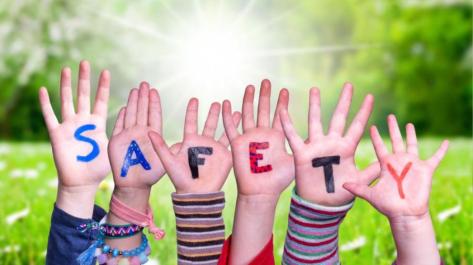Notes from the Parish Nurse - Summer Safety Tips

Summer is a time when we are often out-of-doors biking, picnicking, camping, swimming, boating, and hiking. It is a joyful time to be out in God’s glorious world, but it is also a time to take precautions and be safe. Following are some safety reminders.
Water Safety
• Never let children swim unsupervised, even in backyard pools.
• Learn how to swim and teach your children how to swim.
• At lakes, swim with a buddy and only swim in areas where a lifeguard is present.
• Before diving, be sure the water is deep enough and free from hazards.
• Wear a personal flotation device (PFD) when boating.
• Do not drink alcohol when boating or swimming.
• Watch the weather because lightning and rough water are very dangerous.
• Wear sunscreen that has a sun protection factor (SPF) of 30 or higher to protect your skin from harmful ultraviolet (UVA & UVB) rays.
Heat-Related Illness
• Heat cramps, painful muscle spasms in the legs or abdomen, are often the first sign that someone is having a heat-related illness. Usually resting in a cool place and drinking fluids will help a person recover.
• Heat exhaustion is a more severe form of a heat-related illness. Symptoms include headache, nausea, vomiting, dizziness, and weakness. Skin appears cool, moist, and pale. Treatment includes getting the person out of the heat, loosen tight clothing, apply cool wet cloths to the skin, fan the victim, and give cool water to drink if the person is conscious.
• Heat stroke is the least common but most severe heat emergency. It can occur when a person ignores heat exhaustion symptoms. Signs of heat stroke include red, hot, dry skin; changes in consciousness; rapid, shallow breathing; and rapid, weak pulse. Call 911 immediately. Wrap the person in a cool wet sheet, or place cold packs on the person’s wrists, ankles, groin, and armpits to help cool large blood vessels.
• To prevent heat-related illnesses, be sure to moderate activity when temperatures are high and maintain an adequate intake of fluids. Thirst warns us to replenish our body’s water supply.
July is “Fireworks Eye Safety Awareness Month” and the American Academy of Ophthalmology reminds consumers to “leave fireworks to professionals.” More than 13,000 injuries and 8 deaths related to fireworks happen each year, according to the U.S. Consumer Product Safety Commission. Over 4,000 injuries are head-related and of those nearly 30% are eye injuries. One-fourth of fireworks eye injuries cause permanent vision loss or blindness. These are sobering statistics. “Children are the most common victims of fireworks accidents…” People often think sparklers are “safe” for children to use, but they burn at about 2000 degrees Fahrenheit, which can cause third degree burns. Bottle rockets cause the most serious injuries because of abrupt trauma to the eye. These injuries include: corneal abrasions, retinal detachment, optic nerve damage, eye muscle damage, and complete blindness. Please heed the following tips from the Academy: never let children play with fireworks, view fireworks from a safe distance (500 feet to ¼ mile), respect safety barriers of professionals and leave lighting fireworks to them, do not touch unexploded fireworks that you might find, and seek medical help immediately if you receive an eye injury from fireworks.
More information about eye safety can be found on the following websites: www.aao.org and www.preventblindness.org.
